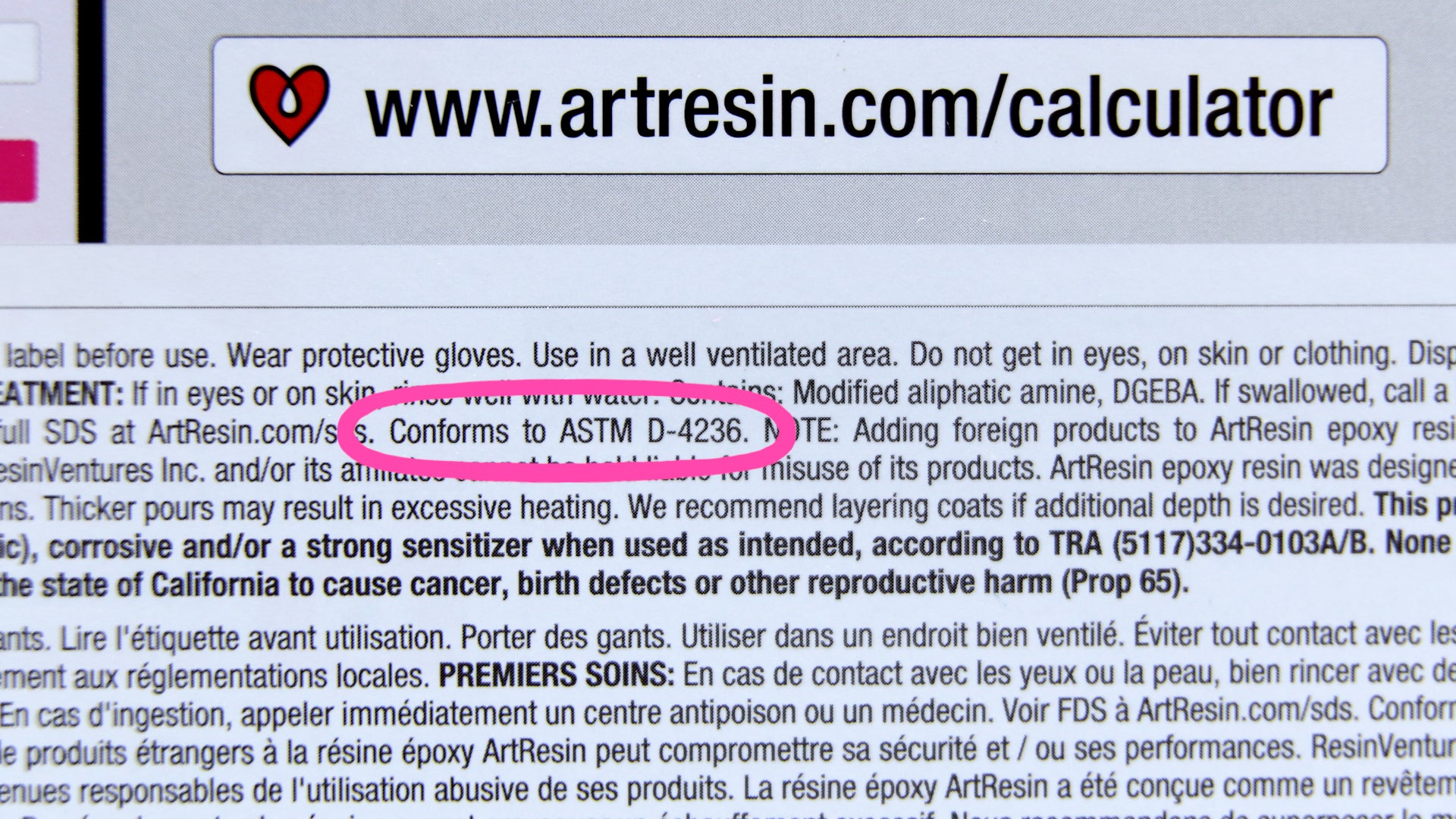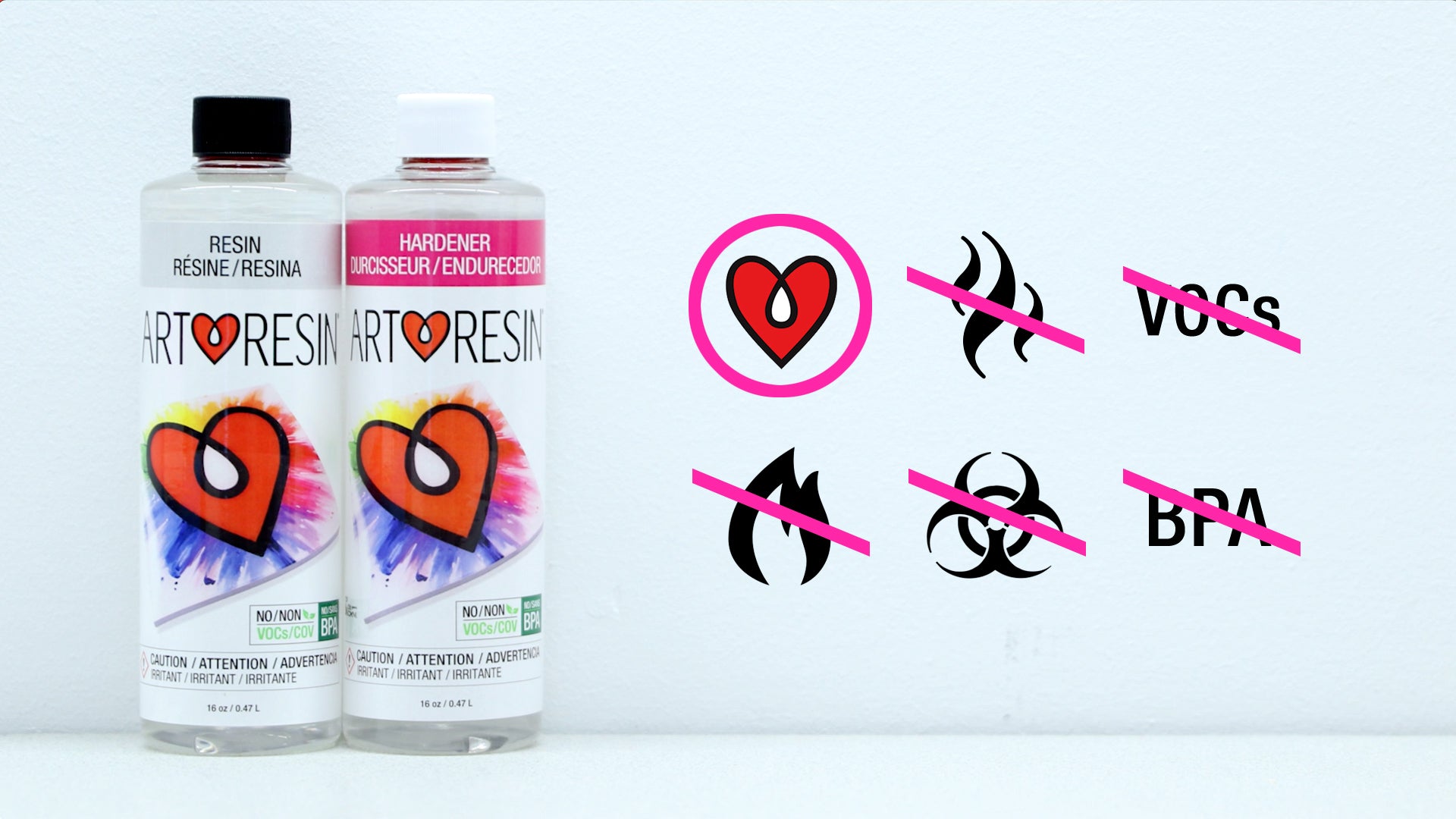Using a food safe epoxy is important for anyone making resin projects that will contact food, such as countertops, boards, or trays. In this article, we'll explore what makes epoxy food safe.
Experimenting with epoxy resin to create beautiful resin art is both fun and rewarding. Be aware, however, that the epoxy resin brand you use will determine how safe it is for your health.
For example, charcuterie boards are popular projects among resin artists and epoxy DIY enthusiasts. It's true that epoxy resin can transform an ordinary slice of wood into a stunning board, but is it actually safe to serve food on a resined surface?

Is Epoxy Resin Safe For Food Contact?
Whether a resin project can come into direct contact with food or not depends on the chemical composition of the products used to make it.
There are many different epoxy resin brands on the market, but not all of them are non-toxic and food safe. In fact, many formulas require warning labels to alert consumers that the product is poisonous, carcinogenic or hazardous to the environment. To ensure that the epoxy resin you’re using is food safe, look for a resin that has been evaluated by an independent lab and whose test results comply with worldwide food safe regulations.
Note : The EU, Australia, Canada, Great Britain and the USA have their own governing bodies that outline food safe regulations. You can check for compliance with food safe standards on the epoxy resin manufacturers’ websites.
Use a food safe epoxy resin to safely prepare or serve food on the following surfaces:
- Charcuterie boards
- Serving trays
- Fruit bowls
- Epoxy resin tables
- Drink ware, like mugs and tumblers
- Countertops
- Coasters
- Candy dishes
- Plates or tableware
Please note that a resin is only considered safe for food contact once it has fully cured. Keep food or beverages well away from resin and hardener in its pre-cured, liquid form. Epoxy resin is not edible or potable in either liquid or cured form.

What Exactly Does "Food Safe Epoxy" Mean?
A “food safe epoxy resin” means that when the product is used as directed and fully cured, it is inert and will not leach any chemicals into food that comes into contact with it.
Epoxy resin is a material created from the chemical reaction between resin and hardener. Some epoxy resin formulas contain solvents and diluents to stretch the materials - these non-reactive fillers can leach out of the product and pose serious health risks if breathed in or ingested.
Ensure that the epoxy resin you’re using is a food grade epoxy by consulting the manufacturer’s safety certifications on their website, the Safety Data Sheet, and by accurately following the recommended mixing instructions.
Some of the most established food safety certifications for epoxy resin are:
- US: FDA 21 CFR 175.300 Resinous and Polymeric Coatings
- EU: Food Contact Plastics Regulations EU 10/2011
- GB: GB 4806.7-2016 National Standards For Food Safety
- AUS: AS 2070-1999 Plastic Materials For Food Contact Use
- CA: Canada Consumer Product Safety Act SOR 2018/83
Understanding FDA Compliance
What does “FDA compliant epoxy” mean in the first place?
The U.S. Food and Drug Administration (FDA) evaluates materials that contact food. Epoxy resins must meet strict FDA guidelines to be certified as food safe, assessing potential chemical migration into food. Only products passing these assessments are deemed FDA compliant. This means they are safe for prolonged and direct contact with food.
For practical applications like kitchen countertops, serving boards and trays, epoxy resins undergo extensive testing to simulate actual use. Formulations that are found not to leach harmful substances into food receive FDA approval.
ArtResin® Epoxy Resin is one of the few epoxy resins to have been tested for leaching in 13 different food safety tests and passed each one. ArtResin not only gives your creations a beautiful, shiny finish, but it is 100% food safe once cured.
To see ArtResin’s leaching and migration test results across worldwide standards and regulations, read our blog ArtResin Passes Food Safety Tests.
Factors Determining The Food Safety of Epoxy Resin
Key Considerations for Ensuring Food Safety with Epoxy Resin
While not all epoxy resins are suitable for contact with food, it's crucial to follow best practices even when using a food safe epoxy resin, like ArtResin. Here are the key considerations:
1. Accurate Measuring and Mixing
It's crucial to follow the manufacturer's instructions for measuring and mixing the resin and hardener. Incorrect ratios or insufficient mixing will prevent the components from bonding and curing properly.
2. The Curing Process
Allowing epoxy resin to fully cure is essential for projects intended for food contact. Complete curing ensures no active components remain in the resin. Strictly follow the manufacturer's guidelines on mixing ratios and curing times to avoid under-cured products that may contaminate food.
3. Additives and Colorants
Additives and colorants can enhance the appearance of epoxy resin, but it's crucial to ensure they are non-toxic and comply with food safety regulations. Otherwise, they may pose risks if they come into contact with consumables. If in doubt, apply a final coat of clear epoxy resin over top.
In short, ensuring that food-safe resin remains food safe involves three key practices: following label instructions for measuring and mixing, ensuring complete curing, and using non-toxic additives or a clear top coat. These steps allow you to be creative while maintaining safety.
Are Epoxy Resin Colorants Food Safe?
Even if your epoxy resin is non-toxic and non-flammable, adding certain resin dye or colorants can compromise the product’s safety designation. For example, alcohol ink is a flammable solvent and once it has been added to an epoxy resin creation, the resin is no longer considered non-toxic. Alcohol ink can be used in resin to create stunning pieces of petri art. Just remember not to use alcohol ink for crafting resin pieces intended for food.
For those looking for a safe colorant to add to your epoxy resin work, take a look at ResinTint liquid colorants. They are non-toxic, mineral oil-based, contain no solvents, and were designed specifically to work with epoxy resin.
💡Tip: If you’re not sure that the colorant you’re using is non-toxic, simply add an extra layer of clear, non-tinted, food-safe ArtResin® as a final topcoat on your epoxy creations to ensure it is safe for use in direct contact with food.

What Is BPA?
BPA stands for Bisphenol A; a chemical compound used to manufacture clear and durable epoxy resins and other polycarbonate plastics that come in direct contact with food products. Some studies have shown that BPA might be connected to specific health problems, however, the United States Food and Drug Administration (FDA) has declared that BPA is safe at very low levels.
How To Protect Yourself Against BPA In Epoxy Resin?
Should BPA worry you? For peace of mind and to reduce exposure to BPA while crafting resin artwork, your best line of defense is to choose a BPA-free epoxy resin, like ArtResin®!
How is ArtResin A BPA-Free Epoxy Resin?
ArtResin is BPA-free, non-toxic and does not release harmful chemicals. Here are the facts:
- BPA is one of the precursors to epoxy, but it is fully reacted during Artresin’s manufacturing process, leaving behind only trace amounts. These trace amounts are so low that ArtResin epoxy resin is certified as BPA-free.
- ArtResin is a complete system, meaning that Parts A and B of the ArtResin formula - the resin and the hardener - fully react when combined, leaving nothing behind that can become airborne. There is no chance of exposure to even those miniscule amounts of BPA. It also means there are no volatile organic compounds (VOCs) or other harmful solvents released into the air.
- Once cured, ArtResin is compliant with FDA CFR 175.300 and “may be safely used as the food-contact surface of articles intended for use in holding food” and “intended for repeat food-contact use”.
ArtResin® has undergone numerous in-depth safety evaluations and environmental tests to ensure that it is safe to use. Learn more about them in the video below.
For more information, see our blog ArtResin Safety Certifications - What Do They Mean?
How Do I Know If My Epoxy Resin Is Food Safe?
Check on your resin’s label for hazardous symbols, precautionary statements and for information about food safety grade and toxicity. For more detailed information, consult the Safety Data Sheet (SDS) on the manufacturer’s website. There you’ll be able to see the chemical properties and classifications of the resin components as well as personal protective measures to ensure your safety. If you still have concerns and questions, contact the manufacturer through their customer hotline or their website contact form.

Read our blog ArtResin Passes Food Safety Tests!
General Safety Rules For Working With Epoxy Resin
ArtResin® Epoxy Resin is safe to use because it contains no solvents, no BPA and does not release toxic substances like VOCs that can put your health at risk. Be aware, however, that not all epoxy resin brands are non-toxic: many are considered hazardous materials and should not be used without following safety precautions. If in doubt, look for the safety standard “ Conforms to ASTM D-4236” and “ Safe For Use At Home” on the label, like you'll find on ArtResin's label.
To protect your health, make sure you follow these best practices:
- Wear disposable, nitrile gloves while in contact with epoxy resin
- Choose long-sleeved clothing.
- Work in a well-ventilated space.
- Avoid eating or drinking while crafting with epoxy resin.
- When sanding cured epoxy resin, wear a safety mask to avoid inhaling sanding dust.
- Clean up spills and drips on work surfaces immediately.
- Do not use alcohol, acetone, vinegar or other solvents to wipe epoxy resin from your skin. Instead, use an exfoliant cleanser.
- Remove all traces of epoxy resin with alcohol before washing tools in hot soapy water.
- Do not pour liquid epoxy resin or hardener down the drain.
- Do not use non-food safe epoxy resin to craft surfaces and objects that come in direct contact with food.
- Check the epoxy resin manufacturer’s safety data sheet to get informed about potential hazardous compounds that may be present in the resin and hardener you use.

Treat Skin Irritation Promptly
When working with resin, always wear disposable nitrile gloves to minimize skin exposure and possible irritation. If you experience a reaction such as skin irritation or swelling after working with epoxy resin, discontinue use and seek prompt medical advice.
Approximately 2% of users will experience an allergy to the basic components of epoxy resin. Skin reactions may present as itching, irritation redness, swelling or blisters and typically subside once exposure is discontinued. Allergic reactions are unpredictable, however: you may experience a reaction right away or an allergy could develop over time with repeated exposure. An allergic reaction to epoxy resin is not specific to a certain brand - if you experience an allergic reaction one epoxy resin, you will react to them all and the advice would be to discontinue use indefinitely.

ArtResin's Non-Toxic and Food Safe Status Can Change With The Addition Of Foreign Products
ArtResin is non-toxic on its own but be aware that adding products that contain toxins and solvents will alter its safety status. For example, adding alcohol ink to resin creates a cool, colorful effect, but alcohol is a solvent which means the final product can no longer be classified as non-toxic.
Similarly, ArtResin is non-flammable in its liquid form when used as directed, and we recommend using an Maker’s Studio Torch to pop bubbles. Running a flame quickly and systematically over the entire resin surface will eliminate any trapped bubbles and not cause a flammability risk. However, if flammable products, like alcohol ink, have been added to the mixture, it will compromise the non-flammability of liquid ArtResin.
For this reason, we have developed ResinTint , our non-toxic, non-flammable premium colorant for ArtResin. If you're looking for a colorant for your ArtResin and want to preserve the non-toxic, non-flammable nature of the formula, then ResinTint is the perfect option!

Want To Learn More About ArtResin's Safety?
We want you to feel confident about ArtResin's safety. For more information, please see our Safety Data Sheet.
It's important to us that ArtResin is a product that's easy to use, beautiful, and safe to use at home or in the studio. We hope that all of this information gives you peace of mind to get creative without concern, but if you have any questions, please leave them in the comments below.
Do you want to learn more about epoxy resin and safety? Read our guides below:
- Is ArtResin Safe For Home Use?
- What Safety Precautions Should I Take When Using ArtResin?
- What Makes ArtResin Safe?
- Is ArtResin Food Safe?
- Safety Certifications - What Do They Mean?
- Is Epoxy Resin Toxic?
- Non Toxic Epoxy Resin
- Is ArtResin BPA Free?
- Can You Be Allergic To Epoxy Resin?
- Is Your Epoxy Resin Dangerous?
Find Food-Safe Epoxy Resin For Your Projects
Wondering where to buy food-safe epoxy resin? Look no further than ArtResin, your trusted partner for your artistic endeavors. Create arts & craft projects without worries, knowing you've chosen the best.
ArtResin: The Original Epoxy For Resin Art.


